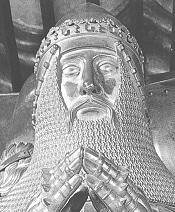Edward, the Black Prince
|
|
Edward_the_Black_Prince_-_Illustration_from_Cassell's_History_of_England_-_Century_Edition_-_published_circa_1902.jpg

Edward of Woodstock, Prince of Wales, known as the Black Prince (June 15, 1330 – June 8, 1376) was the eldest son of King Edward III of England and Philippa of Hainault. Born at Woodstock Palace in Oxfordshire, he was created earl of Chester in 1333, Duke of Cornwall in 1337, becoming the first English Duke created, and Prince of Wales in 1343, and proved to have a prodigious military talent, as shown by his bravery at the Battle of Crécy when he was only sixteen. He followed this up ten years later with victory at the Battle of Poitiers, and in 1367 with the victory at Najera in northern Castile.
He continued the practice of using Welsh and English archers in the English army, and the English owed much of their subsequent military success to the supremacy of the longbow over the continental crossbow. He was also one of the first military leaders to introduce a uniform: he did so for his Cheshire and Flintshire troops, who were clothed in green and white cloth.
The emblem of the Prince of Wales's feathers and its accompanying motto, Ich dien (German: "I serve"), are said to have been inherited by the prince from King John of Bohemia, against whom he fought in the Battle of Crécy. According to legend, after the battle, the prince walked over to the king of Bohemia's dead body. The King had ridden into battle despite his blindness, and Edward admired his bravery. He picked up the King's helmet, lined with ostrich feathers, and took the King's motto, Ich dien. However, this emblem and motto were not exclusively used by the Black Prince, but also by his brothers.
Blakprin.JPG
Edward had been brought up with his cousin, Joan "The Fair Maid of Kent". After marrying her in October, 1361 (a controversial match), Edward was sent to rule the province of Aquitaine as prince on behalf of his father. In this period, he had two sons, Edward (who died in infancy) and Richard, who would later rule as Richard II of England. He was given the lordship of Biscay by Pedro I of Castile in 1367.
His military campaigning on behalf of Pedro, King of Castile, known to his enemies as 'Pedro the Cruel', ruined Edward's health as well as his finances, and he was forced to give up the administration of Aquitaine in 1371 and return to England. Whilst making an attempt to involve himself in the government of England, he soon had to give up any hope of resuming military activity, and he died at Westminster on Trinity Sunday, June 8, 1376, leaving his young son as heir to the throne. He is buried in Canterbury Cathedral.
Edward is almost always now called the "Black Prince," but he was never known as such during his lifetime (instead being known as Edward of Woodstock after his place of birth). The "Black Prince" title was coined at least 200 years after his death. Its origin is uncertain; while some later historians have speculated that he may have worn black armour, or a black surcoat over his armour, it is also likely that the name was first coined by French chroniclers in reference to the ruinous military defeats he had inflicted on France.
In the movie A Knight's Tale, Edward is a fairly minor character who nonetheless plays a pivotal role at the climax of the story. He is shown earlier in the film disguising himself as a minor nobleman to compete in jousting tournaments without receiving special treatment due to his royal status.
Further reading
- Richard Barber, The Life and Campaigns of the Black Prince, ISBN 0851154697
| Preceded by: Edward II | Prince of Wales 1330–1376 | Succeeded by: Richard II | ||
| Preceded by: Edward III | Duke of Aquitaine 1361–1376 | Succeeded by: Richard II
de:Edward von Woodstock fr:Prince Noir hr:Edward Crni Princ nl:Edward de Zwarte Prins ja:エドワード黒太子 pt:Eduardo, Príncipe de Gales sv:Edvard, den svarte prinsen |
